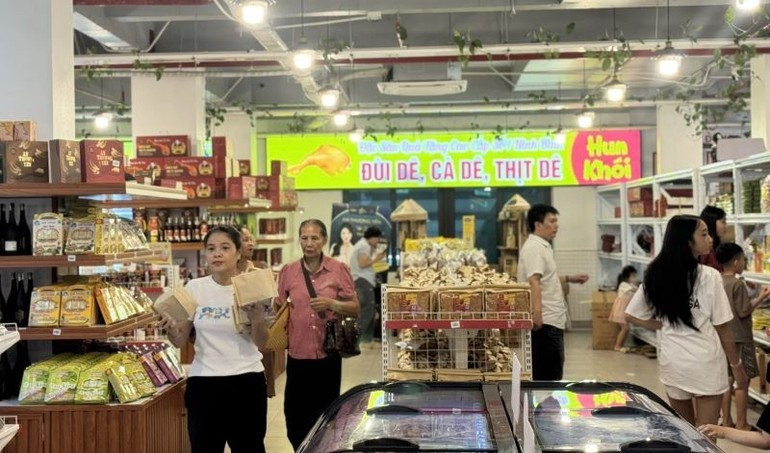Viet Nam in the global retail recovery stream
In the picture of many restructuring movements, Viet Nam stands out as a dynamic market, with clear signs of recovery.

Specifically, after a series of consecutive years affected by the pandemic, supply chain disruptions and macroeconomic instability, the global retail industry is gradually returning to a clear but uneven recovery cycle. Some traditional models are facing the need to restructure, while flexible, experiential and technology-integrated retail formats are rising strongly.
The return of a resilient industry
Contrary to concerns that e-commerce will completely “replace” physical retail, the reality shows that global consumers are returning to stores as a shopping-experience-interaction destination. Savills’ Impacts 2025 report highlights that retailers around the world are recovering better than expected, with clear evidence from the US market: shopping centre visits in 2024 increased by 1.5% compared to the previous year and 7.3% compared to the pre-pandemic period of 2019. Nearly 80% of total consumer spending in the US is still done in traditional stores, a very significant proportion in the digital age.
In Viet Nam, Ho Chi Minh City is playing a leading role in this process. In the first quarter of 2025, the total retail supply in the city reached 1.6 million m2, up 6% compared to the same period in 2024. Occupancy reached an impressive 94%, reflecting real demand from both tenants and consumers. Despite slight adjustments due to the entry of new projects with low prices, the average ground floor rental price still reached 1.4 million VND/m2/month, up 9% year-on-year.

Modern retail models continue to demonstrate their superiority. Shopping malls such as Thiso Mall Sala, Vincom Mega Mall Grand Park or Parc Mall recorded occupancy rates of over 70% immediately after opening. Meanwhile, street retail is increasingly showing its inferiority due to the lack of investment in experience, amenities and professional operations - factors that are increasingly being prioritised by consumers.
In Ha Noi, the same period recorded a sharp increase of 6% year-on-year in ground floor rental prices, with the central area alone increasing by 37%. The occupancy rate reached 86%, while new contracts recorded a shift away from F&B - which used to dominate - to fashion, cosmetics and convenience stores.
Retail tenants are leading, investment follows
If capital was previously the “first wave” that drove retail, now it is retail brands that are taking the lead in reshaping the market. The expanding demand of fashion, cosmetics, interior and F&B brands is playing a leading role – thereby attracting the return of investors.
However, many investors are still hesitant due to the impact of previous investments in inefficient retail assets. According to the ANREV Investment Intentions Survey, the proportion of retail real estate allocated to global organizations’ portfolios in 2025 is forecast to be only 12.4%, much lower than the 27.7% in 2018. However, signs of recovery are becoming increasingly clear. In 2024, capital flows began to accelerate again, especially in the second half of the year.

Tran Pham Phuong Quyen, Senior Manager, Savills Retail Leasing Department shared that in the context of many international brands considering the Southeast Asian market, Viet Nam has the advantage of a young, dynamic population pursuing shopping trends, with a desire for more experiences. In addition, labour, construction and warehousing costs are still lower than many countries in the region, helping brands easily optimise costs and achieve greater profit potential.
The biggest focus is on assets with good operational capabilities and adhering to an omnichannel retail strategy - from large-scale shopping centers in developed residential areas to suburban retail parks. In addition, the post-pandemic revaluation of assets has created more favourable conditions for investors, while the yield of this segment is now much more attractive than that of housing or logistics - two segments that were pushed up in price due to the massive inflow of money before.
Retail as an operating asset
A major change in investment thinking is taking place in the industry: retail is no longer simply a rental property. In the context of consumers increasingly demanding experiences and brands, retail real estate is now considered an operating asset - where a close combination of operations, technology, tenant brands and deep understanding of customer behaviour is required.

Modern shopping malls need to be managed as a complete ecosystem. From the leasing industry, customer flow, marketing strategy to space design and accompanying amenities - all affect operational performance and asset value. The retail leasing market in the next few years will shift strongly towards consulting depth. Not only stopping at connecting leasing needs with available premises, both tenants and landlords are gradually turning to professional consulting units - with data tools, analysis and technology to filter out the most suitable premises for each stage. The service of representing tenants and landlords will play a big role in reshaping the negotiating position and operational efficiency.
In addition, not only operating premises, developing an effective shopping mall requires a synchronous and long-term strategy. Therefore, investors need to ensure that the design of the rental space meets standards, build a capable leasing and operating team, and at the same time have a methodical communication plan to turn the project into a true destination in the area. Pursuing retail real estate is a long journey.
In 2025, the retail industry has officially returned to the growth track but not in the old way. In an increasingly competitive market in terms of experience and operations, Viet Nam, especially Ho Chi Minh City, possesses the advantage of a young population, dynamic consumer behavior and reasonable operating costs - enough to become a strategic destination for international brands in the coming period.
Experts also warn that the Vietnamese retail industry in 2025 is at a crossroads: either innovate to go far, or be swept away in the global economic storm. Businesses need the companionship of policies, from tax incentives to investment in logistics infrastructure and above all, consumer trust - the factor that connects everything.
As affirmed by Nguyen Anh Duc, Chairman of the Viet Nam Retailers Association, localities need to re-plan the trade sector, prioritize the development of modern logistics centers, synchronise warehouses and transportation to reduce costs, and increase the competitiveness of Vietnamese goods.
Duc added that, along with the digital trend, green retail is reshaping the market. Consumers, especially young people, increasingly prioritise environmentally friendly products, from organic foods to recycled packaging.








